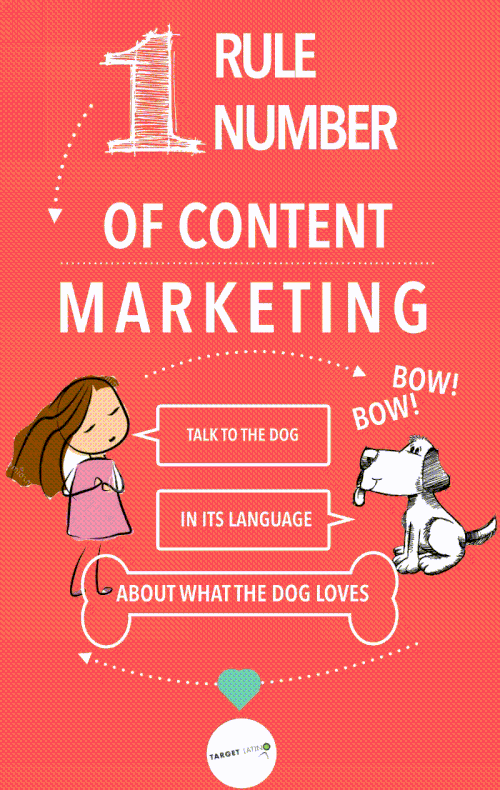Why Your Hispanic Content Marketing Strategy is Not Working
You are investing in a Hispanic content marketing strategy and it’s not paying off? Maybe it’s time to find out if you are committing one of the cardinal sins of Hispanic content marketing.
We are seeing a lot more interest in the Hispanic market.
First, because Hispanics are a market that is growing disproportionately. One in 3 babies born in the U.S. today is Hispanic. By 2050, Hispanics will constitute a full 30 percent of the U.S. population. “By 2044, the United States is projected to become a plurality nation. While the non-Hispanic White alone population will still be the largest, no race or ethnic group is projected to have greater than a 50 percent share of the nation’s total. The child population within the United States is even more diverse and is projected to experience the majority- minority crossover in 2020, just 5 years into the future.” Source: U.S. Census Bureau.
Second, because the Hispanic market has reached 1.5 trillion dollars in spending power.
Third, because Hispanics don’t just speak “Spanish” anymore. 😉 (Please, understand that Hispanics have been speaking both English and Spanish for a long time. It just seems that only recently companies have realized about it).
Coincidentally, this last reason is one of the main causes for failure of most Hispanic Content marketing efforts. Let’s analyze the most important ones but before diving into it, let’s review what a content marketing strategy is all about.
“Content marketing is a strategic marketing approach focused on creating and distributing valuable, relevant, and consistent content to attract and retain a clearly-defined audience — and, ultimately, to drive profitable customer action.” Source: Content Marketing Institute
Therefore, Hispanic content marketing must appeal to the U.S.-Hispanic audience and not only to Spanish-speaking Hispanics.
We all know the first rule for Content Marketing: Talk to your customer, in your customer’s language about what your customer loves. So, do you truly understand what this customer loves? And which one of these Hispanic content marketing cardinal sins are you committing?
1Brands confuse Hispanic content marketing with Spanish content marketing
Have you ever seen an American suddenly begin to speak Spanish as its primary or dominant language? Brands need to pay attention to the demographics. Approximately 86 percent of Hispanics under the age of 18 are born in the U.S. and 95 percent of Millennials are U.S. born,
Therefore, not all content should be in Spanish. As a matter of fact, there is a growing segment of the Hispanic population that doesn’t speak Spanish at all. This audience has such a wide range of acculturation levels that go from speaking only Spanish to only English. Thinking that you are targeting Hispanics with a Spanish-only content marketing strategy is a delusion.
If you are interested in truly understanding acculturation levels, I recommend you read this article: Understanding Hispanic Market Segmentation and Acculturation.
2Not using English-language Hispanic targeted content.
I will also include here thinking that your English content strategy will take care of Hispanic consumers.
General market content strategies always target a segment of the population. Maybe it’s soccer moms, maybe it’s newlyweds, maybe it’s golfers. For a successful content marketing strategy, brands have marketing personas in mind. Why this concept disappears when it comes down to the Hispanic consumers, baffles me. Just like you don’t write your content for all audiences your English language Hispanic targeted content needs to be developed via marketing persona and and understanding of culture codes.
The addition of proper research and culture codes will enable a deeper understanding of the motivations for this particular segment. Blanketing Hispanics with labels such as “brand-loyal” doesn’t really apply when targeting Hispanic Millennials.
Another example is the Hispanic relationship to “Money” that varies with levels of acculturation. For more on how to use to craft messages that resonate with this audience, read the Hispanic culture code for money article.
Brands may be offering the same products or services but they need to be communicated in different ways.
3Using cultural clichés when developing Hispanic content
Assuming that all Latinos relate to or search for Latino cuisine images is the equivalent of going after the general market with apple pie and burger photos because we assume it’s relevant to the culture.
Ignoring customer insights or professional research is the same as putting yourself in the path to failure, willingly. Do not choose a Hispanic content marketing campaign because it has personal significance to your VP of marketing or to your Hispanic employees. A single opinion does not speak for the whole audience. Back it up with market research.
4Not considering mobile viewability or shareability first
Hispanics do over-index in mobile. Not just when they are young and U.S.-born but also when they are recent arrivals. One of the main reasons for the high incidence of digital Latinos is the lack of telecom infrastructure in Latin America that led to a huge adoption of mobile devices and the use of SMS or text messages due to its lower cost.
Hispanic will be viewing your content on mobile devices and ignoring this fact is the same as placing advertisement where your target audience cannot see it.
Because Hispanics over index on Social Media as well, making sure your content can be shared on mobile it’s a must.
Hispanic market content needs to be searchable, engaging and shareable.
5You are ignoring analytics
Data analysis speaks volumes on the online world. And for Hispanic content marketing to be successful, analyzing results and responding to the analysis of the results, is key. Unfortunately I have rarely seen gap analysis performed, no matter what the market. Seasoned Hispanic inbound marketing professionals can help you understand your content’s current state and develop more where you’re missing out while keeping it aligned with your buyer’s needs. Content has to convert. Data analysis and conversion rate optimization needs to happen so you can adjust your content and its calls to action to improve results.
6Not having a documented Hispanic content marketing strategy
All strategies have to be documented and your Hispanic content marketing strategy is no exception. Without a written strategy, you are just winging it. There’s no goals, nothing to measure your results against. Basically, no way of knowing if you are on the right track. Do not miss out on Hispanic marketing personas, and not knowing your customers deeply. In the end, that’s who you are developing content for.
7You’re just afraid of failure
You need to invest time, budget and resources in this market and if you do, you will be rewarded with incredible results. The companies producing the most content for the Hispanic market are the same companies finding the most success in building long-term relationships with US Hispanics. Great examples of these companies are: T-mobile, Procter & gamble, Walmart, Target, and Toyota. AT&T, with its mobile movement – upwardly mobile campaign showed us how relating to U.S.-born Hispanics is possible. Sprint is making the U.S. Hispanic market a much bigger priority this year. Not enough budget to plan, prepare specific content, promote on social media channels, and analyze its results, will definitely lead to failure. The rewards for executing a solid Hispanic content marketing strategy are long lasting and will far surpass your expectations.
Basically, Hispanic content marketing not only drives positive brand engagement but, because the market over indexes other demographics on mobile and social media, it does it with much higher success rate than with non-Hispanics.
If you are lukewarm about it or go after it pinching pennies, you will not have the results of this growing and ever-present market.
Every day more and more content is produced. A trend that will stay with us for a long time. For your content to be found and consumed it has to be more engaging, have more quality and satisfy the market’s needs. Relevancy is key, and with a growing Hispanic market you cannot afford to waste time and money with mistakes on your Hispanic content marketing strategy.
My advice is to partner with a Hispanic inbound agency that is bilingual, bicultural and passionate about understanding cultures. One that spends hours studying and analyzing their similarities and differences between the cultures, because understanding only one culture is understanding none.
And remember the mantra: Create. Curate. Optimize. Convert.







I find that one of the biggest mistakes companies make is they continue to pigeonhole us into a certain stereotype and that is one of the worst things you can do. Companies are marketing to individuals and human beings not to a minority that has money.
Thanks for getting awareness of the importance of the Hispanic consumer!
Diana,
You can say that again!! The stereotype is that the Hispanic market is poor but our purchasing power proves the opposite. Also, Nielsen publishes very nice statistics and studies on wealthy Latinos and few are tapping that market.
Havi
Great insight! I used to see the same situation on the hiring side. Who the companies hired for their LATAM marketing spot. Back in the day, corporations would hire third generation IVY Leaguers with Spanish Sur name to fill this spot. Their LATAM offices and USA office hardly exchange information with each other. That is where the lack of education about the Hispanic´s demographics starts. Last year, I lost a major Japanese client because they decided to direct all their LATAM marketing out of Los Angeles office. (Closed Mexico, Argentina and Brazil)
If you look at the demographic of today compared to 25 years ago, the Hispanic market was culturally divided geographically through out the country. New York was mostly Puerto Rican. Miami was mostly Cuban. California and Texas Mexican. Now is completely diversified. Miami and New York City are one of the biggest melting pots of Hispanics. First, the companies have to be educated or have educated individual that are conscious of the market and are open to new marketing strategies. Objectively open to see how their product fits into the equation.